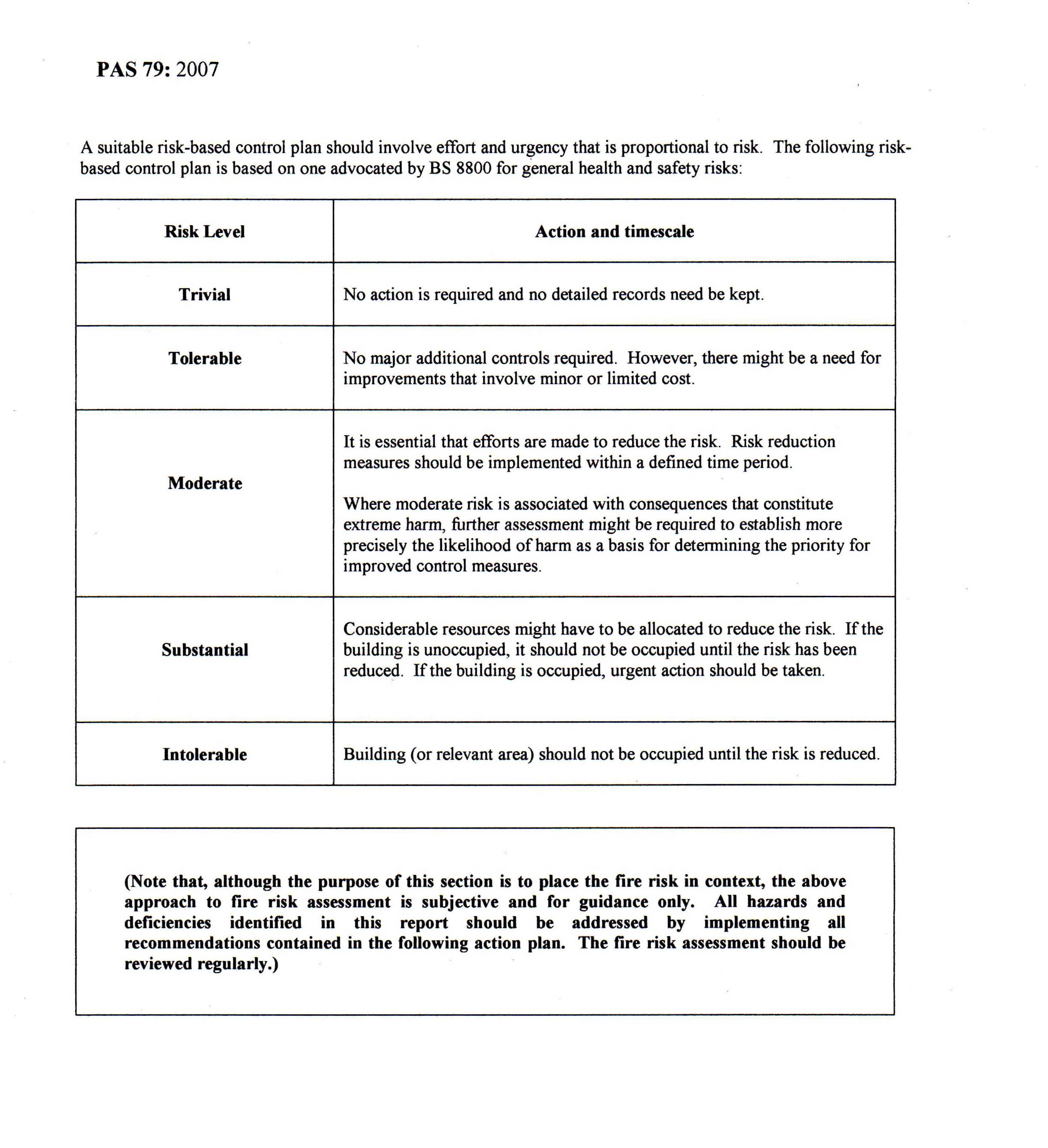Information
-
Document No.
-
Audit Title
-
Client / Site
-
Conducted on
-
Report produced by
-
Competent Person (CP)
-
Name of Responsible Person (RP)
-
Location
-
Previous assessment date
-
Previous assessment carried out by;
-
Previous assessment actions complete
-
Emergency services contact details
Property Details (Section 1)
-
1.1 Site location details
-
1.2 Is the location deemed to be remote or have difficulty accessing all or part of the site
-
1.2 Number of floors:
-
1.3 Approximate floor area:
-
1.4 Brief details of construction:
-
1.5 Use of premises:
-
1.6 Relevant Fire Safety Legislation
-
1.7 The above legislation is enforced by:
-
Any other comments
Occupant Details (Section 2)
-
2.1 Approximate maximum number of occupants:
-
2.2 Approximate numbers of employees at any one time:
-
2.3 Maximum number of members of the public at any one time:
-
2.4. The Occupants at Risk from Fire
-
2.5 Sleeping occupants at risk from fire:
-
2.6 Disabled occupants at risk from fire:
-
2.7 Occupants in remote areas and lone workers:
-
2.8 Young persons at risk from fire:
-
Any other comments
Fire Loss Experience (Section 3)
-
3.1 Any history of fire loss
-
3.2 Any visit / notices from relevant authorities
-
3.3 Any history of alarm activations
-
3.4 Any history of live evacuations
Training and information (Section 4)
-
4.1 Have staff received fire awareness training
-
4.2 Are there any Appointed Person(s)
-
4.2.1 Names of Appointed Person(s)
-
4.2.2 Duties of Appointed Person(s)
-
4.3 Name(s) and positions of Relevant Persons
-
Duties / roles of RP's
-
4.4 Is there a Fire warden nominated
-
4.4.1 Name of Fire Warden(s)
-
4.4.2 What training have Fire Warden(S) been given
-
4.4.3 What equipment have Fire Warden(S) been provided
-
4.4.4 What actions are expected of the Fire Warden in the event of an evacuation
Electrical (Section 5)
-
5.1 Reasonable measures taken to prevent fires of electrical origin?
-
5.2 Fixed installation periodically inspected and tested?
-
5.2.1 Period of inspection
-
5.2.2 Date of last inspection
-
5.2.3 Company / person that undertook test
-
Is this persons competencies known
-
Detail of competency / qualification of suitability
-
5.3 Portable Appliances periodically inspected and tested?
-
5.3.1 Period of inspection
-
5.3.2 Date of last inspection
-
5.3.3 Company / person that undertook test
-
Is this persons competencies known
-
5.4 Description of policy regarding the use of personal electrical appliances?
-
5.5 Suitable limitation of trailing leads and adaptors?
Smoking / Vaping (Section 6)
-
6.1 Reasonable measures taken to prevent fires as a result of smoking / Vaping?
-
6.2 Smoking / Vaping prohibited in the building?
-
6.3 Smoking / Vaping areas provided
-
6.4 This policy appeared to be observed at time of inspection?
Heating (Section 7)
-
7.1 Is the use of portable heaters avoided as far as possible?
-
7.2 If portable heaters are used, is the use of the more hazardous type (eg. Radiant bar fires or lpg appliances) avoided?
-
7.3 If portable heaters are used, are suitable measures taken to minimise the hazard of ignition of combustible materials?
-
7.4 Are fixed heating installations subject to regular maintenance?
-
7.4.1 Period of inspection
-
7.4.2 Date of last inspection
-
7.4.3 Company / person that undertook test
-
Is this persons competencies known
-
Detail of competency / qualification of suitability
Security (Section 8)
-
8.1 Is there a risk of Arson
-
8.1.2 What measures are taken to reduce risk
-
8.2 Externally to the premises are there stores of combustibles / waste that could be used to start a fire
-
8.2.1 What measures are taken to reduce risk
Cooking (Section 9)
-
9.1 Is there any cooking or heating of food in the premises
-
9.2 What cooking appliances are provided
-
9.3 What risk level is apportioned to these
-
Is extraction provided
-
Period of inspection
-
Date of last inspection
-
Company / person that undertook test
-
Is this persons competencies known
-
Detail of competency / qualification of suitability
-
Is Ansul Provided
-
Period of inspection
-
Date of last inspection
-
Company / person that undertook test
COSHH (Section 10)
-
10.1 Are there any COSHH substances held that are flammable or highly flammable?
-
10.1.1 Are these stored in suitable cabinets
-
10.1.2 Are these stored in reasonable quantities
DSEAR (Section 11)
-
Does the location have any hazards relating to DSEAR?
-
Is a suitable RA in place
Evacuation (section 12)
-
12.1 It is considered that the building is provided with with reasonable means of escape in case of fire.
-
12.1.1 Number of fire exit routes
-
12.1.2 Do any exits lead direct to external area
-
12.1.3 Do doors on exit routes open outwards
-
12.2 Are fire doors provided
-
12.2.1 What if known is the FD number of the door
-
12.2.2 Are a minimum of 3 hinges fit to fire doors
-
12.2.3 Are hinges designed to BS EN 1935
-
12.2.4 Are the hinges of suitable construction for the weight of the door
-
12.3 Are exit routes deemed suitable for the number and ability of persons required to escape
-
12.4 Are doors being held open so that they will not close on activation of the alarm
-
12.5 Are Escape routes unobstructed?
-
12.6 It is considered that the building is provided with reasonable means of escape for disabled people?
-
12.7 It is considered that there is compartmentation of a reasonable standard?
-
12.8 It is considered that there is reasonable limitation of linings that may promote fire spread?
-
12.9 As far as can reasonably be ascertained, fire dampers are provided as necessary to protect critical means of escape against passage of fire, smoke and combustion products in the early stages of a fire?
-
12.10 Is signage suitable on evacuation route
-
12.11 Is there an evacuation plan / instructions posted in a visible position
-
12.12 Reasonable manually operated electrical fire alarm system provided?
-
12.12.1 Has this been incorporated in to building tests and checks
Emergency lighting (Section 13)
-
13.1 Has a reasonable standard or emergency escape lighting system been provided?
-
13.1.1 Period of test / checks
-
13.1.2 Have required test / checks been carried out
Fire alarm system (Section 13)
-
13.1 Reasonable manually operated electrical fire alarm system provided?
-
13.1.1 Has this been incorporated in to building tests and checks
-
13.2 Automatic fire detection provided?
-
13.2.1 Has this been incorporated in to building tests and checks
Fire Fighting equipment (section 14)
-
14.1 What classification of fires are possible with regards to site hazards
-
What fire fighting media is required
-
14.2 Hose reels provided?
-
14.1.1 Any defects with equipment
-
14.1.2 Date of last competent engineer inspection
-
14.2 Are portable fire fighting appliances supplied
-
14.2.1 Any defects with equipment
-
14.2.2 Date of last competent engineer inspection
-
14.3 Are automated suppressant systems installed
-
14.3.1 Any defects with equipment
-
14.3.2 Date of last test / checks
-
14.4 Other relevant fixed systems and equipment, type of fixed system:
Conclusion
-
Summary of findings
-
Taking into account the fire prevention measures observed at the time of this risk assessment, it is considered that the hazard from fire (likelihood of fire) at these premises is:
-
In this context, a definition of the above terms is as follows: LOW: Unusually low likelihood of a fire as a result of negligible potential sources of ignition. Medium: Normal fire hazards (e.g. potential ignition sources) for this type of occupancy, with fire hazards generally subject to proper controls (other than minor shortcomings). High: Lack of adequate controls applied to one or more significant fire hazards, such as to result in significant increase in likelihood of fire.
-
Taking into account the nature of the building and the occupants, as well as the fire protection and procedural arrangements observed at the time of this fire risk assessment, it is considered that the consequences for life safety in the event of fire would be:
-
In this context, a definition of above terms is as follows: Slight harm - Outbreak of fire is unlikely to result in serious injury or death of any occupant (other than an occupant sleeping in a room in which fire occurs). Moderate harm: Outbreak of fire could foreseeably result in injury (including serious injury) of one or more occupants, but it is unlikely to involve multiple fatalities. Extreme harm: Significant potential for serious injury or death of one or more occupants.
-
Accordingly, it is considered that the risk to life from fire at these premises is:
-
Comments:
-
Photos of supporting evidence
-
Level of risk explained:
-
Signature of Client:
-
Signature of Assessor:











